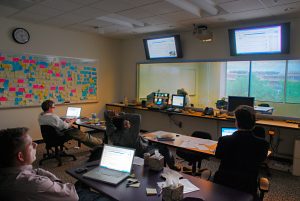This week we went to our first UX conference of the year, The UX conference in London organized by the school of UX. An insightful day filled with 10 practical UX design talks. We are happy to share a few takeaways in this blogpost.
The first fun idea that we want to share with you, was the use of the online platform sli.do for questions during the talks. The event came up with this idea because visitors are often too shy to ask questions, and it was a great success.
First of all, Joost van der Ree from Uber taught us how to make design decisions if there are a lot of constraints in three steps.
- Know the context. Apart from just understanding the problem, understand the context that the solution needs to be a part of.
- Be aligned on a goal. Define the problem, priorities and principles, together with your team and stakeholders.
- Define the ideal product. Create a vision of what the ideal product could be, without too many constraints. Be careful, don’t make compromises too fast.
“Design depends largely on constraints… Here is one of the few effective keys to the design problem-the ability of the designer to recognize as many constraints as possible-his willingness and enthusiasm for working within these constraints-the constraints of price, of size, of strength, balance, of surface, of time etc.; each problem has its own peculiar list.” – Charles Eams
 After that Ben Franck from British Gas persuaded us to involve stakeholders in our user tests. They created an observation room next to their user testing room, where everyone from the design team, the product team, management and other stakeholders can come and follow the user tests. They provide screens and sound, post-it walls, print-outs and everyone is welcome. Stakeholders have often no idea how a user test works and by showing them they tend to really understand and appreciate the insights from the ux team. They have had more than 2000 visitors in their observation room in the past 3 years.
After that Ben Franck from British Gas persuaded us to involve stakeholders in our user tests. They created an observation room next to their user testing room, where everyone from the design team, the product team, management and other stakeholders can come and follow the user tests. They provide screens and sound, post-it walls, print-outs and everyone is welcome. Stakeholders have often no idea how a user test works and by showing them they tend to really understand and appreciate the insights from the ux team. They have had more than 2000 visitors in their observation room in the past 3 years.
The last speaker that we will discuss was Byron Fernandes from Moo, who gave some tips about handling conflicts in our work life. This might sound a bit strange at first, but as ux designers we often meet people who think on a totally different level then us. It isn’t always easy to explain your insights and your designs, and this may lead to some discussions. A few tips for handling these:
1. Listen (like Louis Theroux)
- Give your full attention
- Show that you’re listening
- Ask open questions
- Reflect, clarify and summarize
- Set aside your judgement
2. Speak with their perspective in mind
- They don’t know the things that you know
- They may not know the things that they think they know
3. Don’t be afraid to disagree
but if you do
4. Disagree effectively
“Listen not for the purpose of judging, criticizing or analyzing. Listen only to help the other person to express themselves.” – Thich Nhat Hanh
Off course, many other interesting speakers and talks passed by, but if you want to know more about them as well, you’ll need to be there next year!


